Friction
1. Friction
Friction is a contact force that opposes the relative motion or tendency of relative motion of two bodies.
Consider a block on a horizontal table as shown in the figure. If we apply a force, acting to the right, the block remains stationary if F is not too large. The force that counteracts F and keeps the block in rest from moving is called frictional force. If we keep on increasing the force, the block will remain at rest and for a particular value of applied force, the body comes to state of about to move. Now if we slightly increase the force from this value, block starts its motion with a jerk and we observe that to keep the block moving we need less effort than to start its motion.
So from this observation, we see that we have three states of block, first, block does not move, second, block is about to move and third, block starts moving. The friction force acting in three states are called static frictional force, limiting frictional force and kinetic frictional force respectively. If we draw the graph between applied force and frictional force for this observation its nature is as shown in figure.
1.1 static frictional force
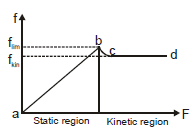
When there is no relative motion between the contact surfaces, frictional force is called static frictional force. It is a self-adjusting force, it adjusts its value according to requirement (of no relative motion). In the taken example static frictional force is equal to applied force. Hence one can say that the portion of graph ab will have a slope of 45º.
The Direction of Static Friction
The direction of static friction on a body is such that the total force acting on it keeps it at rest with respect to the body in contact.
The direction of static friction is as follows. For a moment consider the surfaces to be frictionless. In absence of friction the bodies will start slipping against each other. One should then find the direction of friction as opposite to the velocity with respect to the body applying the friction.
1.2 Limiting Frictional Force
This frictional force acts when body is about to move. This is the maximum frictional force that can exist at the contact surface.
(i) The magnitude of limiting frictional force is proportional to the normal force at the contact surface.

Here ms is a constant the value of which depends on nature of surfaces in contact and is called as `coefficient of static firction'.
1.3 Kinetic Frictional Force
Once relative motion starts between the surface in contact, the frictional force is called as kinetic frictional force. The magnitude of kinetic frictional force is also proportional to normal force.

From the previous observation we can say that 
Although the coefficient of kinetic friction varies with speed, we shall neglect any variation i.e., when relative motion starts a constant frictional force starts opposing its motion.
Direction of Kinetic Friction
The kinetic friction on a body A slipping against another body B is opposite to the velocity of A with respect to B.
It should be carefully noted that the velocity coming into picture is with respect to the body applying the force of friction.
Suppose we have a long truck moving on a horizontal road. A small block is placed on the truck which slips on the truck to fall from the rear end. As seen from the road, both the truck and the block are moving towards right, of course the velocity of the block is smaller than that of the truck. What is the direction of the kinetic friction acting on the block due to the truck ? The velocity of the block as seen from the truck is towards left. Thus, the friction on the block is towards right. The friction acting on the truck due to the block is towards left.
Ex.1 Find the direction of kinetic friction force

(a) on the block, exerted by the ground.
(b) on the ground, exerted by the block.
Sol. (a) (b)
where f1 and f2 are the friction forces on the block and ground respectively.
Ex.2 The correct relation between magnitude of f1 and f2 in above problem is :
(A) f1 > f2
(B) f2 > f1
(C) f1 = f2
(D) not possible to decide due to insufficient data.
Sol. By Newton's third law the above friction forces are action-reaction pair and equal but opposite to each other in direction. Hence (C)
Also note that the direction of kinetic friction has nothing to do with applied force F.
Ex.3
All surfaces are rough. Draw the friction force on A & B
Sol.
Kinetic friction acts to reduce relative motion.
Summary
We can summarise the laws of friction between two bodies in contact as follows:
(i) If the bodies slip over each other, the force of friction is given by

where N is the normal contact force and μk is the coefficient of kinetic friction between the surfaces.
(ii) The direction of kinetic friction on a body is opposite to the velocity of this body with respect to the body applying the force of friction.
(iii) If the bodies do not slip over each other, the force of friction is given by

where μs is the coefficient of static friction between the bodies and N is the normal force between them. The direction and magnitude of static friction are such that the condition of no slipping between the bodies is ensured.
(iv) The frictional force fk or fs does not depend on the area of contact as long as the normal force N is same.
Ex.4 A block of mass 5 kg is resting on a rough surface as shown in the figure. It is acted upon by a force of F towards right. Find frictional force acting on block when
(a) F = 5N
(b) 25 N
(c) 50 N (ms = 0.6, mk = 0.5) [g = 10 ms-2]
Sol. Maximum value of frictional force that the surface can offer is
fmax = flim = μsN
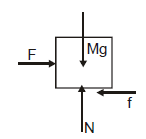
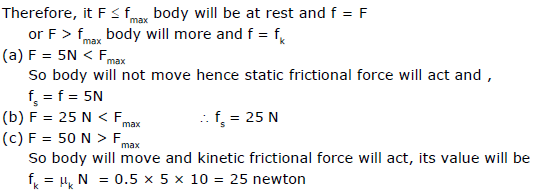
Ex.5 A block having a mass 3 kg is initially at rest on a horizontal surface. The coefficient of static friction μs = 0.3 between the block and the surface and μk is 0.25. A constant force F of 50 N, acts on the body at the angle θ = 37º. What is the acceleration of the block ?
Sol. We have two possibilities here, the block may remain at rest, or it may accelerate towards the right. The decision hinges on whether or not the x-component of the force F has magnitude, less than or greaer than the maximum static friction force.
The x-component of F is
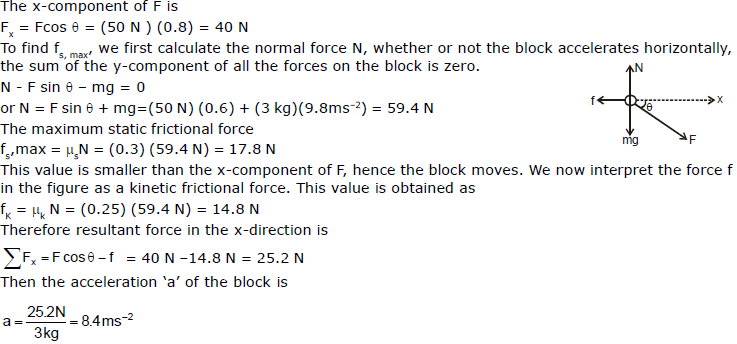
Think : What would happen if the magnitude of Fx happened to be less than fs.max but larger than fk ?
Ex.6 In the previous example, suppose we move the block by pulling it with the help of a massless string tied to the block as shown here. What is the force F required to produce the same acceleration in the block as obtained in the last example ?
Sol. We are given that,
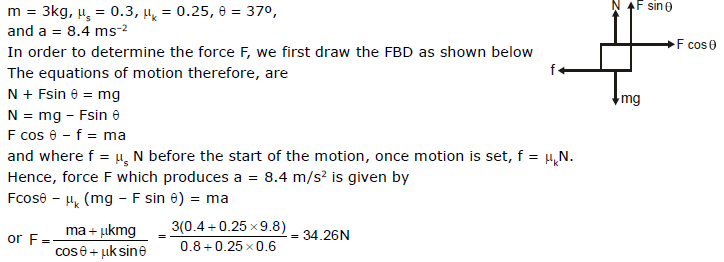
: Fsinθ works out to be less than mg. Otherwise we would lift the block up in the above analysis
Comment
It is easier to pull then to push. Only about 34 N force is required to pull than 50 N required during pushing why ?
Because, when we pull at an angle, the effective normal force N by which block is pressing down on surface is reduced and consequently friction is reduced. Just the contrary happens when you are pushing.
2. Minimum force required to move the particle :
A body of mass m rests on a horizontal floor with which it has a coefficient of static friction m. It is desired to make the body slide by applying the minimum possible force F.
Fig. A
Let the applied force F be at angle f with the horizontal
R = Normal force
Fig. B
For vertical equilibrium,
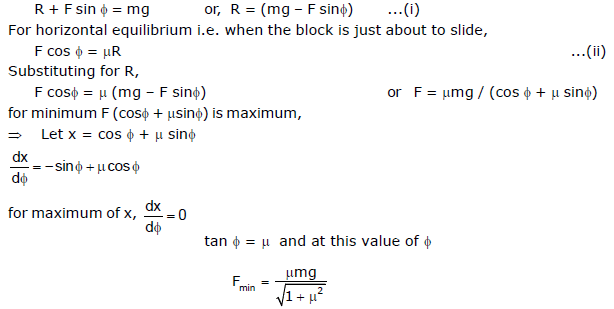
3. Friction as the component of contact force :
When two bodies are kept in contact, electromagnetic forces act between the charged particles at the surfaces of the bodies. As a result, each body exerts a contact force on other The magnitudes of the contact forces acting on the two bodies are equal but their directions are opposite and hence the contact forces obey Newton's third law.
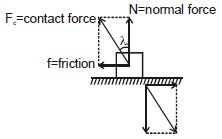
The direction of the contact force acting on a particular body is not necessarily perpendicular to the contact surface. We can resolve this contact force into two components, one perpendicular to the contact surface and the other parallel to it. The perpendicular component is called the normal contact force or normal force and parallel component is called friction.
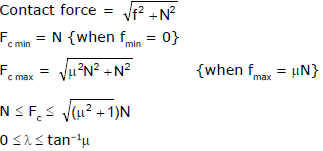
Ex.7 A body of mass 400 g slides on a rough horizontal surface. If the frictional force is 3.0 N, find (a) the angle made by the contact force on the body with the vertical and (b) the magnitude of the contact force. Take g = 10 m/s2.
Sol. Let the contact force on the block by the surface be Fc which makes an angle l with the vertical (shown figure)
The component of Fc perpendicular to the contact surface is the normal force N and the component of F parallel to the surface is the firction f. As the surface is horizontal, N is vertically upward. For vertical equilirbrium,
N = Mg = (0.400 kg) (10 m/s2) = 4.0 N
The frictional force is f = 3.0 N
(a) or, λ = tan-1 (3/4) = 37º
(b) The magnituded of the contact force is
=
4. MOTION ON A ROUGH INCLINED PLANE
Suppose a motion up the plane takes place under the action of pull P acting parallel to the plane
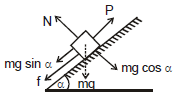

The frictional force would then act up the plane

Ex.8 A 20 kg box is gently placed on a rough inclined plane of inclination 30° with horizontal. The coefficient of sliding friction between the box and the plane is 0.4. Find the acceleration of the box down the incline.
Sol. In solving inclined plane problems, the X and Y directions along which the forces are to be considered, may be taken as shown. The components of weight of the box are
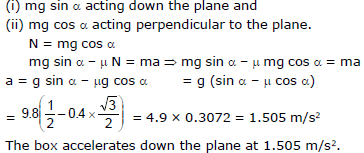
Ex.9 A force of 400 N acting horizontal pushes up a 20 kg block placed on a rough inclined plane which makes an anlge of 45° with the horizontal. The acceleration experienced by the block is 0.6 m/s2. Find the coefficient of sliding friction between the box and incline.
Sol. The horizontally directed force 400 N and weight 20 kg of the block are resolved into two mutually perpendicular components, parallel and perpendicular to the plane as shown.

-
- 421.4 μ = 20a = 20 × 0.6 = 12
=
= 0.3137
The coefficient of sliding friction between the block and the incline = 0.3137
5. Angle of Repose :
Consider a rough inclined plane whose angle of inclination q with ground can be changed. A block of mass m is resting on the plane. Coefficient of (static) friction between the block and plane is μ.
For a given angle q, the FBD (Free body diagram) of the block is

6. Two blocks on an inclined plane :
Consider two blocks having masses m1 & m2 placed on a rough inclined plane. m1 & m2 are the friction coefficient for m1 & m2 respectively. If N is the normal force between the contact surface of m1 & m2
Now three condition arises.
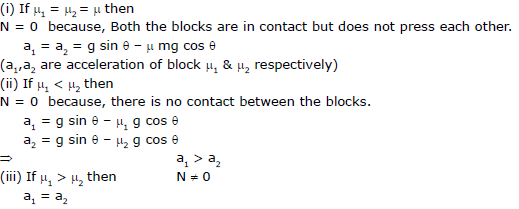
Ex.10 Mass m1 & m2 are placed on a rough inclined plane as shown in figure. Find out the acceleration of the blocks and contact force in between these surface.
Sol. As we know if μ1 > μ2 both will travel together so
a1 = a2 = a
F.B.D
which is equivalent to
a = a =
= 3.6 m/sec2
Now F.B.D of 1 kg block is
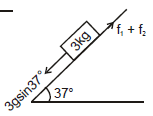
gsin37° + N - 4 = (1) a
N = 3.6 + 4 - 6 = 1.6 Newton
7. Range of force F for which acceleration of body is zero.
Ex.11 Find out the range of force in the above situation for which 2kg block does not move on the incline.
Sol. F.B.D of 2 kg block
Now take different value of F
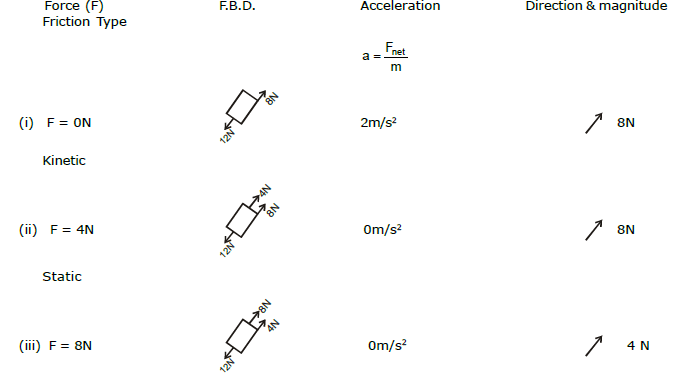
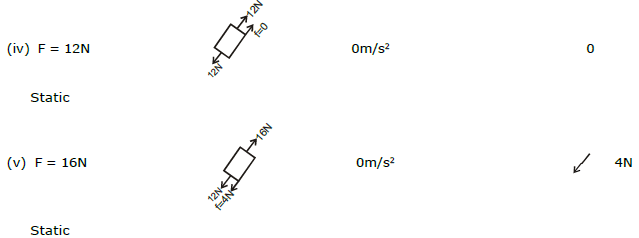
(in this condition friction change its direction to stop relative slipping)
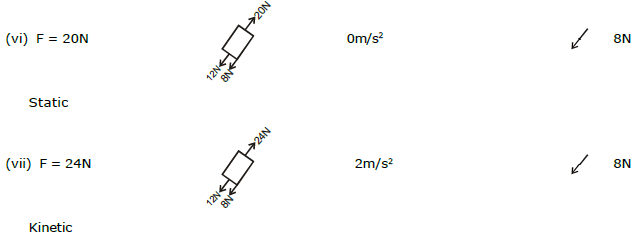
From the above table block doesn't move from F = 4N (mgsinθ - μmgcosθ) to F = 20N (mgsinθ + μmgcosθ). So friction develope a range of force for which block doesn't move
: If Friction is not present then only for F = 12N the block will not move but friction develop a range of force 4N to 20N to prevent slipping. So we can write the range of force F for which acceleration of the body is zero.

Ex.12 In the following figure force F is gradually increased from zero. Draw the graph between applied force F and tension T in the string. The coefficient of static friction between the block and the ground is μs.
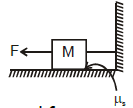
Sol. As the external force F is gradually increased from zero it is compensated by the friction and the string beares no tension. When limiting friction is achieved by increasing force F to a value till ms mg, the further increase in F is transferred to the string.
Ex.13 Fig. shows two blocks tied by a string. A variable force F = 5t is applied on the block. The coefficient of friction for the blocks are 0.6 and 0.5 respectively. Find the frictional force between blocks and ground as well as tension in the string at
(A) t = 1 s (B) t = 2s (C) t = 3s
Sol.
(a) At t = 1s, F = 5 × 1 = 5 N
Maximum value of friction force
fA = μN = 0.5 × 20 = 10 N
To keep the block stationary the magnitude of frictional force should be 5N. So
fA = 5 N
Now from the figure it becomes clear that if
fA = 5N & F = 5 N, Tension T = 0
Since tension is not in application so frictional force on block B is 0 i.e.,
fB = 0
(b) At t = 2s, F = 5 × 2 = 10 N
Maximum value of friction force
f = μN = 0.5 × 20 = 10 N
To keep the block stationary the magnitude of friction force should be 10 N. So
fA = 10 N
From the figure it is clear that if
fA = 10 N and F = 10 N
Tension T = 0
Hence friction force on block B is fB = 0
(c) At t = 3s, F = 5 × 3 = 15 N
Maximum value of friction force
f = μN = 0.5 × 20 = 10 Newton
Again applying the same analogy fA = 10 N
From the figure it is clear that if
fA = 10 N and F = 15 N
Tension T = 5 N
So frictional force on block B is fB = 5 Newton
Ex.14 Find the tension in the string in situation as shown in the figure below. Forces 120 N and 100 N start acting when the system is at rest.
Sol. (i) Let us assume that system moves towards left then as it is clear from FBD, net force in horizontal direction is towards right. Therefore the assumption is not valid.
Above assumption is not possible as net force on system comes towards right. Hence system is not moving towards left.
(ii) Similarly let us assume that system moves towards right.
Above assumption is also not possible as net force on the system is towards left in this situation. Hence assumption is again not valid.
Therefore it can be concluded that the system is stationary
Assuming that the 10 kg block reaches limiting friction first then using FBD's
120 = T + 90 ⇒ T = 30 N
Also T + f = 100
 30 + f = 100 ⇒ f = 70 N
30 + f = 100 ⇒ f = 70 N
which is not possible as the limiting value is 60 N for this surface of block.
 Our assumption is wrong and now taking the 20 kg surface to be limiting we have
Our assumption is wrong and now taking the 20 kg surface to be limiting we have
T + 60 = 100 N ⇒ T = 40 N
Also f + T = 120 N ⇒ f = 80 N
This is acceptable as static friction at this surface should be less than 90 N.
Hence the tension in the string is T = 40 N
8. Pulley block System involving friction :
- If friction force is acting and value of acceleration of a particle is negative, then it means direction of friction force is opposite to that what we assumed and acceleration would be having a different numerical value.
Ex.15 Two blocks of masses 5 kg and 10 kg are attached with the help of light string and placed on a rough incline as shown in the figure. Coefficients of friction are as marked in the figure. The system is released from rest. Determine the acceleration of the two blocks.
Sol. Let 10 kg block is sliding down, then acceleration of both the blocks are given by,
It means our assumed direction of motion is wrong and 5 kg block is going to slide down, if this would be the case, the direction of friction force will reverse and acceleration of blocks would be given by :
= -ve
It means in this direction also there is no motion. So we can conclude that the system remains at rest and friction force is static in nature.
9. Two Block System :
Ex.16
Find out the maximum value of F for which both the blocks will move together
Sol. In the given situation 2kg block will move only due to friction force exerted by the 4 kg block
F.B.D.
The maximum friction force exerted on the block B is
fmax = μN
fmax = (0.5) (20) = 10 N
So the maximum acceleration of 2 kg block is

amax is the maximum acceleration for which both the block will move together. i.e., for a £ 5 ms-2 acceleration of both blocks will be same and we can take both the blocks as a system.
F.B.D
Fmax = 6 × 5 = 30 N
for 0 < F < 30
Both the block move together.
Ex.17 In the above question find the acceleration of both the block when
(i) F = 18 N (ii) F = 36 N
Sol. (i) Since F < 30 both the blocks will move together
F.B.D
(ii) When F = 36 N
When F > 30 both the blocks will move separately so we treat each block independently
F.B.D of 2 kg block
aB = 5 m/s2
F.B.D of 4 kg block
Ex.18
Find out the range of force in which both the blocks move together
Sol. If f1 is friction force between block A & lower surface and f2 is friction force between both the block's surface.
F.B.D

f1 max = m1N1 = (0.1) (60) = 6 N
f2 max = m2N2 = (0.5) (20) = 10 N
Upper 2kg block is move only due to friction force so maximum acceleration of that block is
This is the maximum acceleration for which both the blocks will move together.
Therefore for a £ 5ms-2 we can take both the blocks as one system.
F.B.D.
For F < 6 N. Blocks will not move at all.
Now the value of Fmax for which both the blocks will move together.
Fmax - 6 = 6 × 5
Fmax = 36 N
Conclusion if
0N < F < 6N No blocks will move
6N < F < 36 N Both blocks will move together
F > 36 N Both move separately.
Ex.19
The lower block A will move only due to friction force
F.B.D.
fmax = mN = (0.5) (20) = 10 N
F.B.D. of 4 kg blocks
The maximum acceleration of 4 kg block is
This is the maximum acceleration for which both the blocks move together
Fmax for which both the blocks will move together
Fmax = 2.5 × 6 = 15 N
Ex.20
If f2 is the friction force between A & B and f1 is the friction force between A & floor
f1 max = 6 N
f2 max = 10 N
Lower block A will move only due to friction force So amax for 4 kg block

This is the maximum acceleration for which both the blocks will move together
F - 6 = 6 × 1
F = 12 N
If F is less than 6N both the blocks will be stationary
Conclusion :
0 < F < 6 N = Both blocks are stationary
6 N < F < 12 N = Both move together
F > 12 N = Both move separately
Ex.21 Find the accelerations of blocks A and B for the following cases.
(A) m1 = 0 and m2 = 0.1 (P) aA = aB = 9.5 m/s2
(B) m2 = 0 and m1 = 0.1 (Q) aA = 9 m/s2,
aB = 10 m/s2
(C) m1 = 0.1 and (R) aA = aB = g = 10 m/s2
m2 = 1.0
(D) m1 = 1.0 and (S) aA = 1, aB = 9 m/s2
m2 = 0.1
Sol. (a) R, (b) Q, (c) P, (d) S
(i) FBD in (case (i))
{m1 = 0, m2 = 0.1}
While friction's work is to oppose the relative motion and here if relative motion will start then friction comes and without relative motion there is no friction so both the block move together with same acceleration and friction will not come.
(ii)
Friction between wall and block A oppose relative motion since wall is stationary so friction wants to slop block A also and maximum friction will act between wall and block while there is no friction between block.
: Friction between wall and block will oppose relative motion between wall and block only it will not do anything for two block motion.
aA = 9 m/s2 ; aB = 10 m/s2
(iii)
Friction between wall and block will be applied maximum equal to 1N but maximum friction available between block A and B is 10 N but if this will be there then relative motion will increase while friction is to oppose relative motion. So friction will come less than 10 so friction will be f that will be static.
by system (20-1) = 2 × a ⇒ a = =9.5 m/s2
(iv) aA =
aB =
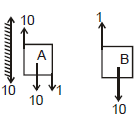
10. Friction involving pseudo concept :
Ex.22 What is the minimum acceleration with which bar A should be shifted horizontally to keep the bodies 1 and 2 stationary relative to the bar ? The masses of the bodies are equal and the coefficient of friction between the bar and the bodies equal to m. The masses of the pulley and the threads are negligible while the friction in the pulley is absent. see in fig.
Sol. Let us place the observer on A.
Since we have non-inertial frame we have pseudo forces.
For body `1' we have,
T = ma mmg ....(1)
For body `2' we have,
N = ma
mg - T - mma = 0
 mg = T mmg ....(2)
mg = T mmg ....(2)
From (1) and (2)
Ex.23
Find out the range of force for which smaller block is at rest with respect to bigger block.
Sol. Smaller block is at rest w.r.t. the bigger block. Let both the block travel together with acceleration a
F.B.D of smaller block w.r. to the bigger block.
fmax = m × N
N = ma
f = mma ...(1)
⇒ f = mg ...(2)
from (1) & (2)
a = g/m = 20 m/s2
So F = 20 (M m) = 20 (5) = 100 N
If F ³ 100 N Both will travel together
Ex.24 The rear side of a truck is open and a box of 40 kg mass is placed 5m away from the open end as shown. The coefficient of friction between the box & the surface below it is 0.15. On a straight road, the truck starts from rest and accelerates with 2 ms-2 . At what distance from the starting point does the box fall off the truck (i.e. distance travelled by the truck) ? [Ignore the size of the box]
Sol. In the reference frame of the truck FBD of 40 kg block

Ex.25 Mass m2 placed on a plank of mass m1 lying on a smooth horizontal plane. A horizontal force F = a0t (a0 is a constant) is applied to a bar. If acceleration of the plank and bar are a1 and a2 respectively and the coefficient of friction between m1 and m2 is m. Then find acceleration a with time t.
Sol. If F < mm2g then both blocks move with common acceleration, i.e., a1 = a2
When F > mm2g, then
Equation for block of mass m
F - mm2g = m2a2 ...(1)
and mm2g = m1a1 ...(2)
From equation (1)
a0t - mm2g = m2a2
i.e., acceleration a2 varies with time linearly,
its slope positive and intercept negative.
From equation (2) a1 is independent of time.
So, the graph between a & t is as follow.
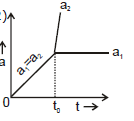
FAQs on NLM - Friction, Chapter Notes, Class 11, Physics (IIT-JEE & AIPMT)
| 1. What is friction according to the article? |  |
| 2. What is the role of friction in physics exams like IIT-JEE and AIPMT? |  |
| 3. What are the factors affecting friction? |  |
| 4. How does friction affect motion in real-life situations? |  |
| 5. What are some practical applications of friction? |  |















